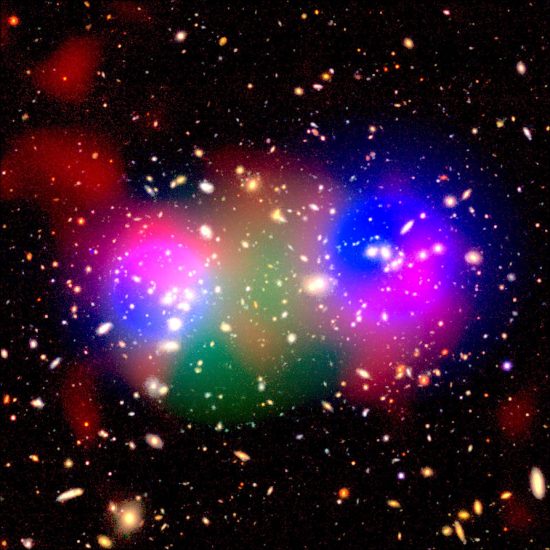
November 16, 2020
The predominant cosmological theory within which most astronomers conduct their research is based on kinetic energy.
In the modern consensus, moving masses and heat are the only factors allowed to operate in the astrophysical Universe. Electric charge is sometimes considered, but it is usually negligible in its effect, if it has an effect at all.
In previous Picture of the Day articles, it was noted that consensus astronomers refer to charged particles streaming from stars like the Sun as a “wind” instead of an electric current. Ions accelerated by a magnetic field are referred to as “jets” instead of the collimated transmission of electrical energy through space, while changes in the density and speed of charged particles are usually deemed to be “shock waves” and not the mark of double layers that can store and dissipate electricity, or even explode.
According to a recent press release, astronomers are considering how remote galaxy clusters can be so hot. HSC J023336-053022 (XLSSC 105) is about 4 billion light-years away (as astronomers reckon distance), and was discovered by ESA’s space-based XMM-Newton X-ray Observatory and NAOJ’s Subaru optical-infrared telescope in Hawaii. As the report notes, “…two sub-clusters within HSC J023336-053022 are slowly moving towards and colliding with one another, ‘shock heating’ gas to intense temperatures in the process.”
In other words, the cluster regions are thought to be incredibly hot because the molecules of gas and dust are crashing into each other, resulting in X-rays flashing out from the blue color-coded regions.
Several computer simulations have been developed over the years so that what is unobservable “billions of light-years” away can be modeled on the desktop. It comes as no surprise that the observations match their simulations. The same ideas used to construct the computer algorithms are also in the minds of those working with the instruments. Building a device that is designed to see what has been simulated is how modern science works. Mathematical formulae make both possible.
Thermal energy is created when atoms collide. Various wavelengths emitted from those collisions correlate to temperature. However, radiant energy in space is synchrotron radiation generated by electrons spiraling through magnetic fields. Electrons in motion are called electricity. Electric charge flow through a magnetic field is defined as a “field-aligned electric current”, otherwise known as a Birkeland current. Birkeland currents release synchrotron radiation, although synchrotron radiation provides no indication of temperature.
Rather than shock waves from a jet of gas, the cluster emits X-rays because electricity is passing through its dusty plasma. X-ray radiation is typical of that given off by highly excited stars, indicating extremely strong electrical stress. No material at “hundreds of million Kelvin” is “hot gas”. No atoms remain intact at such temperatures: electrons are stripped from nuclei, creating powerful electric fields, a characteristic of matter in the plasma state. In that condition, it can conduct electricity and form double layers.
Perhaps the lack of knowledge regarding electricity in space can account for the opinion that “colliding” gases produce X-rays and other energetic emissions. After all, perception comes through training and education, so without exposure to the theories of Kristian Birkeland and Hannes Alfvén regarding the behavior of electricity flowing through plasma no perception of its behavior can exist in the mind’s eye.
Alfvén said:
“The cosmical plasma physics of today . . .is to some extent the playground of theoreticians who have never seen a plasma in a laboratory. Many of them still believe in formulas which we know from laboratory experiments to be wrong . . . several of the basic concepts on which theories of cosmical plasmas are founded are not applicable to the condition prevailing in the cosmos. They are ‘generally accepted’ by most theoreticians, they are developed with the most sophisticated mathematical methods; and it is only the plasma itself which does not ‘understand’ how beautiful the theories are and absolutely refuses to obey them.”
Stephen Smith












